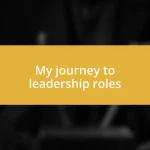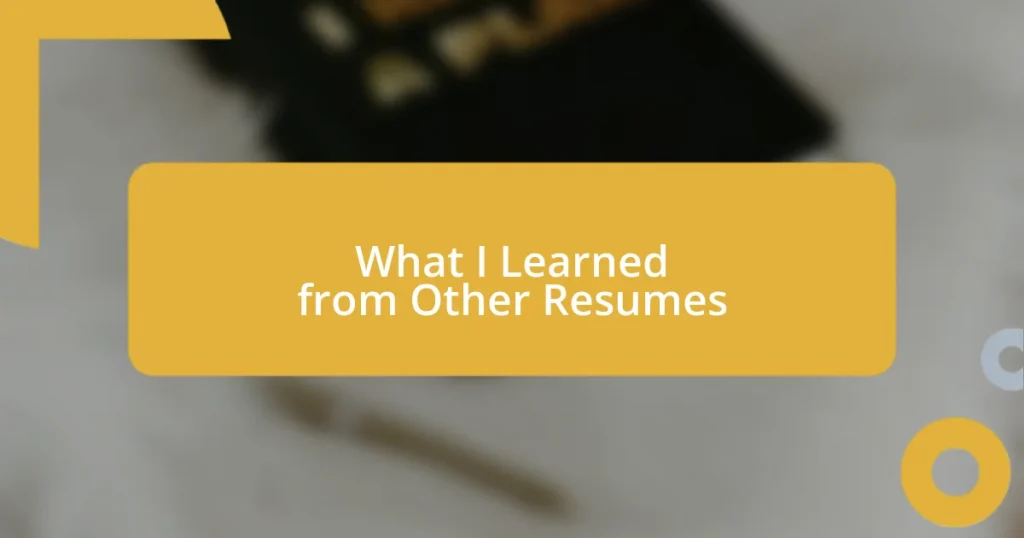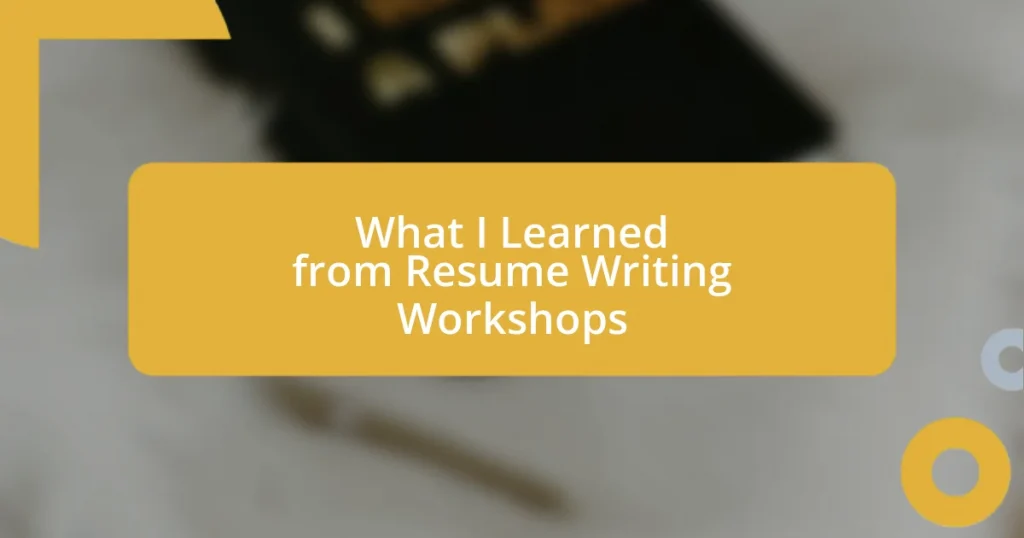Key takeaways:
- Tailor your resume to each job by highlighting relevant skills and accomplishments to resonate with employers.
- Utilize quantifiable achievements and structured formatting to effectively showcase your qualifications and impact.
- Proofread thoroughly and seek feedback from others to ensure clarity and professionalism in your resume presentation.

Understanding resume writing essentials
When I first started revising my resume, I realized that every detail mattered. I remember spending hours perfecting the formatting, ensuring that my name and contact information stood out. After all, isn’t the first impression crucial?
An essential part of resume writing is tailoring your content to the specific job you’re applying for. I learned this the hard way after sending out a generic resume and receiving little response. Now, I always highlight the skills and experiences that directly align with the job description. It’s a game changer to see your application resonate more with prospective employers.
Additionally, a clear structure enhances readability. I made the mistake of packing too much information into one section, thinking that more would impress employers. Instead, I learned that concise bullet points and well-defined sections allow hiring managers to quickly grasp my qualifications. It’s all about presenting relevant information in a digestible way, right?

Analyzing job descriptions effectively
When I started analyzing job descriptions, I found it a bit overwhelming at first. However, breaking them down into specific components helped me clarify what employers were really after. It’s not just about reading the text; it’s about understanding the underlying skills and attributes they value.
Here’s how I approach it:
- Keywords: I highlight key phrases that repeat, which often indicate the skills or experiences that are non-negotiable.
- Essential qualifications: I pay close attention to the required qualifications and reflect on my experiences to draw relevant connections.
- Company culture: I analyze the language for clues about the company culture, which helps me align my personal values in my application.
- Role responsibilities: Knowing what I would be expected to do helps me showcase my past achievements in a way that mirrors these needs.
By diving deep into each job description, I turned what felt like a chore into a strategic exercise. This shift not only guides my resume crafting but also builds my confidence for the interview, knowing I can speak directly to the points that matter most to the employer.

Highlighting key skills successfully
I’ve found that showcasing key skills on a resume is both an art and a science. When I tailored my resume for a marketing position, I made a conscious effort to spotlight skills that align with the role. Instead of a generic list, I focused on specific achievements tied to those skills, like increasing social media engagement by 150%. This approach not only highlighted my capabilities but also illustrated my impact in tangible ways, making a stronger statement to potential employers.
One technique I often utilize is incorporating quantifiable results. When I was applying for a project management role, I crafted my skills section to reflect not just my abilities but also the outcomes. I would mention how I successfully led a team that completed a project 20% under budget. This method of communicating skills creates a narrative that resonates more profoundly, turning abstract skills into concrete results that demonstrate my value.
Here’s a comparison of two ways to highlight key skills in resumes:
| Method | Description |
|---|---|
| Generic Skill Listing | Simply stating skills without context or evidence. |
| Results-Oriented Skill Highlighting | Specifying achievements related to skills, providing evidence of impact. |

Structuring your resume efficiently
Structuring your resume efficiently is about creating a layout that’s both logical and appealing. When I first started, I realized that organizing my experience chronologically helped me present a clear career trajectory. I found that breaking my resume into distinct sections—like education, work experience, and skills—made it easier for hiring managers to navigate. Have you ever noticed how much simpler it is to read a well-structured document?
One strategy that worked wonders for me was using bullet points for my accomplishments. I remember when I applied for a customer service role; my resume turned a wall of text into concise, impactful statements. Each bullet showcased a specific achievement, and it felt like I was telling a story that captured my professional journey rather than just listing tasks. It also made it easier for me to weave in those important keywords that I had identified from job descriptions, ensuring I was speaking the same language as potential employers.
I’ve also learned that the order of information matters. For instance, I’ve started placing the most relevant experience at the top of each section. When I applied for a tech role, I listed my data analysis experience first, even though it wasn’t my most recent position. This way, I could catch the recruiter’s eye immediately. Have you considered what the most important experiences are for the roles you’re targeting? Sometimes, a small adjustment in structure can make a significant difference in presenting your qualifications effectively.

Incorporating measurable achievements
Incorporating measurable achievements in your resume can significantly enhance your appeal to potential employers. I remember when I shifted my focus to quantifying my contributions—it was a game changer. Instead of saying I “managed a team,” I stated that I “led a team of 10 to achieve a 30% increase in project delivery speed.” Seeing that number made hiring managers sit up and take notice. Doesn’t it feel more powerful to show specific results rather than vague descriptions?
One effective method I’ve used is the STAR technique—Situation, Task, Action, Result—whenever I’m crafting statements for my resume. This strategy allows me to tell a concise story while pinpointing the measurable outcomes of my actions. For instance, when I documented my role in reducing customer complaints by 40% through a new feedback system, I not only highlighted my initiative but also anchored it in a quantifiable result. Have you ever thought about what stories your achievements tell? By presenting these narratives with numbers, we elevate our experiences from mere tasks to impactful contributions.
Lastly, don’t underestimate the emotional resonance of measurable achievements. When I stated that I “increased sales by $1 million in just one quarter,” it wasn’t just about the figures; it was about the excitement and teamwork that fueled that success. This isn’t merely bragging—it’s about showcasing your capability to deliver real results that resonate with employers. How do you convey your success stories? Remember, those numbers can speak volumes about your potential.

Finalizing and proofreading your resume
Finalizing your resume is like putting the last brush strokes on a canvas—it’s essential to ensure every element is polished and professionally presented. After I’ve crafted my resume, I always let it sit for a day or so. When I come back to it with fresh eyes, I can spot mistakes or awkward phrasing that I missed before. Have you ever noticed how stepping away can change your perspective? It’s a simple trick that almost always improves the end product.
Proofreading is where I really focus on the details. I like to read my resume out loud, as it helps me catch errors that my eyes gloss over when reading silently. It’s also an opportunity to evaluate the flow and ensure that each section transitions smoothly. I remember the first time I did this—it felt a bit awkward, but hearing my own words truly highlighted areas that needed reworking. Have you tried it? You might be surprised by how much clearer the message becomes.
Finally, I recommend sharing your resume with a trusted friend or mentor for feedback. It can be a game changer to have someone else’s perspective, especially if they know the industry you’re targeting. I once received invaluable advice about adjusting my wording to be more impactful, which made all the difference in capturing the attention of recruiters. So, who can you ask for a fresh pair of eyes on your resume? It’s an opportunity to strengthen your presentation before you send it out into the world.















